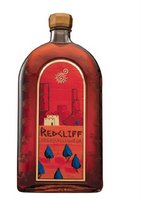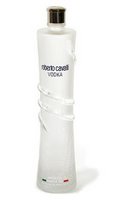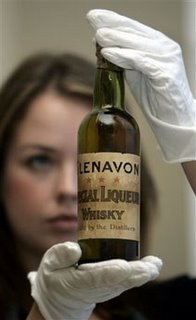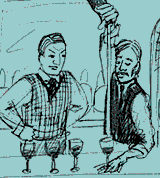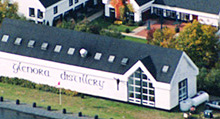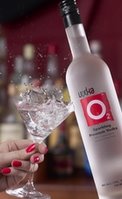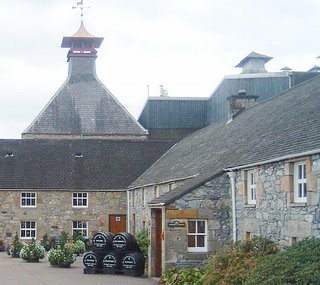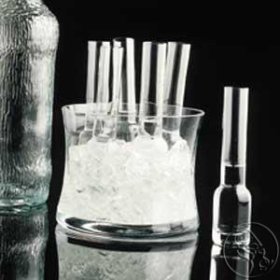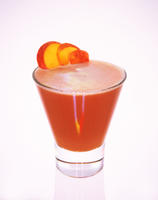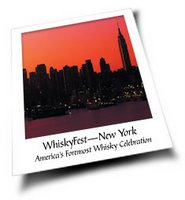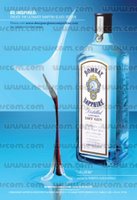Photo by William M. Dowd
NEW YORK -- Gin can be looked at in many ways.
The once-iconic
Cunard luxury sailing liners used it as their premier spirit during the 1930s heyday of trans-Atlantic cruising, helping usher in the American fascination with the cocktail hour.
But it also has been used as a symbol for other levels of society. The writer
John Cheever, for example, employed it to help describe “a lonely man” who, he said, “is a lonesome thing, a stone, a bone, a stick, a receptacle for Gilbey’s gin … .” And jazz great
Thomas “Fats” Waller sang, “Grab your pigs feet, bread and gin, there’s plenty in the kitchen. I wonder what the poor people are eating tonight?”
And then, there is
Sean Harrison, who declares, “Making gin is like cooking. You want to get the flavors just right for people who truly enjoy the taste of what they’re drinking.”
Why, some may ask, should we listen to what Sean Harrison (seen here) has to say about the ancient white spirit that now is battling for its commercial life in an age of vodka?
Simple. He’s the keeper of a coveted two-century-old gin recipe and the master distiller for
Plymouth Gin, the English favorite that not only won “best gin” but “best of show/white spirit” awards at the prestigious San Francisco World Spirits Competition this summer.
Emerging on top of the “best white spirit” category is particularly telling since it includes the ubiquitous vodka that is causing fits for many gin distillers even though they’re dealing with a world that has known gin since it was created in late 16th Century Holland and was, in some regions in the early 1700s, the beverage of choice because milk and water were so unsanitary.
Thus, Harrison and Plymouth are names to be reckoned with.
I joined Harrison for a private gin tasting at celebrity chef
Jean-Georges Vongerichten’s Spice Market restaurant in lower Manhattan recently. Despite a dozen years in the business since he left the Royal Navy as a lieutenant, Harrison still exhibits an enthusiasm for the process of gin making.
He was only two months or so from having made the annual selections of the seven botanicals used in Plymouth Gin -– angelica root, cardamom pods, coriander seeds, lemon peel, orange peel, orris root and, of course, juniper berries that, with alcohol, are the base of all gins and the origin of the drink's name -- a derivation of the French
genievre for juniper.
The Plymouth recipe, developed by Coates & Co. in 1793, doesn’t vary, but the ingredients do. Sound contradictory? Harrison explains.
“We don’t buy any botanical from just one supplier because you never know the quality from year to year, or how a change in the crop of one botanical can interact with another botanical that also might be slightly different from year to year. We get several samples of each and distill sample batches to see what comes closest to our standard for consistent taste.”
Unlike its sales adversary vodka that can be made from virtually any organic matter and usually is a one-ingredient additive to neutral spirits, gin is truly an international melting pot. Orris root usually comes from Italy, juniper berries from Italy and areas of the former Yugoslavia, coriander from sources as disparate as Russia and Morocco, cardamom from Sri Lanka and angelica from Germany and the Netherlands. Thus, climate changes and weather conditions have tremendous influences on the crops.
Plymouth's heritage has given it a special place in British hearts and lore. When German bombs destroyed part of its Black Friars distillery during World War II, the Admiralty sent out a message to the British fleet which used Plymouth as its official gin. British officers in Malta reacted, so the story goes, by offering any gunners who destroyed an enemy ship or plane a bottle of Plymouth Gin.
Despite its success in tasting competitions, and sustained sales on the premium price level, is there room in the U.S. market for more gin in this era of a vodka flood and now a sharp rise in sales of tequila that further muddle the white spirits outlook and vie for a slice of the consumer dollar?
Harrison, obviously, thinks so or he wouldn’t be pushing his product in the States. “I’d much rather be at home making gin,” he says with a smile. “That’s my real job, after all.”
In addition, Harrison, who has delved so deeply into gin chemistry he has even had his ingredients check by gas chromatography -- "although I'm still not sure what that told me," he remarked in a self-effacing tone, expresses polite skepticism with gin recipes that use more than a dozen botanicals. Likewise for flavored vodkas which, he says, eventually will bring some people around to gin which, in essence, is flavored vodka itself since both have a neutral spirits base.
While Plymouth adheres to a generations-old recipe, it did make a major change this year when it redesigned its bottle, always a major undertaking
as I reported back in March.
Bombay Sapphire, one of the top British brands, continues its upscale advertising campaign that features custom-designed cocktail glasses.
Hendrick's, a product of Scotland, pushes its cucumber-tinged product in high-demographic magazine ads.
Citadelle, a French entry, uses the botanical barrage method, trumpeting its 19-botanical recipe that includes such things as Chinese liquorice, French savory and star anise and Indian nutmeg.
These brands, it should be noted, are in the premium category, priced roughly in the $30-and-up range for a 750ml bottle.
A company called Admiral Imports apparently thinks there also is room for a less expensive gin. The American distributor has launched
Iceberg Gin, made by the Canadian Iceberg Vodka Corp. from actual Canadian iceberg water, in the U.S. in five different size bottles, with the popular 750ml bottle priced at $18.99.
Of course, Admiral also imports whiskies with names like Sheep Dip and Pigs Nose from the
Spencerfield Spirit Co. in Fife, Scotland, so Iceberg Gin may just be another attempt at selling a novelty in the faddish and fickle U.S. consumer arena.
To Dowd's Spirits Notebook latest entry.
To Dowd's Wine Notebook latest entry.
To Dowd's Brews Notebook latest entry.
Back to Dowd On Drinks home page.
